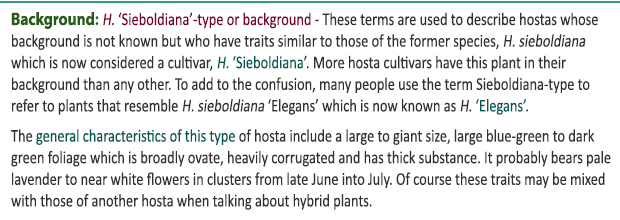|
  Dr. Ralph (Herb) and Dorothy Benedict of Michigan registered this
self-pollinated seedling of H. 'Dorothy Benedict' in 1990.
It is named for their close friend, the former
president of
The American Hosta Society and a
former hosta registrar,
Dr. Jim Wilkins of Michigan. Dr. Ralph (Herb) and Dorothy Benedict of Michigan registered this
self-pollinated seedling of H. 'Dorothy Benedict' in 1990.
It is named for their close friend, the former
president of
The American Hosta Society and a
former hosta registrar,
Dr. Jim Wilkins of Michigan.
With leaves that are cupped,
heavily corrugated with thick substance, this plant forms a
large size
mound about 20 inches high and 40 inches wide. In late
June, it begins to produce near white flowers.
According to
The Hostapedia by Mark Zilis (2009), "...varies from plant to plant,
but most specimens now exhibit gold-centered, dark
green-margined leaves.
Dr. Ed Elslager of Michigan utilized this cultivar in his
breeding work."
 An article about H. 'Dorothy Benedict' by
Herb Benedict in
The
Hosta Journal (1991 Vol. 22 No. 1) states that, "During
1990, the six best, 7 year old seedlings were named and three were registered.
| #1. 'Gil Jones' |
A large upright
H. 'Sieboldiana'-type,
with blue-green leaves and a wide cream edge. |
| #2. 'Jim Wilkins' |
A low spreading reverse with a cream
center and with a blue-green border on its leaves. |
| #3 'Hideko Gowen' |
A tall, upright reverse with a maple
leaf cream center, a wide green edge and a thick cupped round leaf. |
| #4 'Tom Boy' |
A small, slow-growing miniature
H. 'Sieboldiana' with a chartreuse edged, cupped, round green leaf. |
| #5 'Ruby
Benedict' |
A low, spreading, very gold leaf with a
green edge, and a very puckered, round leaf. |
| #6 'Bashful Polly' |
A wavy edged, splashed leaf. |
Another 'Dorothy Benedict' seedling, grown and registered by
Jim Wilkins, is 'Herb Benedict', a splashed, round leaf with blue overtones
and winner of the Savory Shield Award in Jackson (MI), 1988, for the best
new seedling growing in a
National
Convention of The
American Hosta Society tour garden."
An article in
The
Hosta Journal (1999 Vol. 30 No. 2) states that a pot of
this cultivar sold for $1,400 at The American Hosta Society
Convention auction that year.




 |



